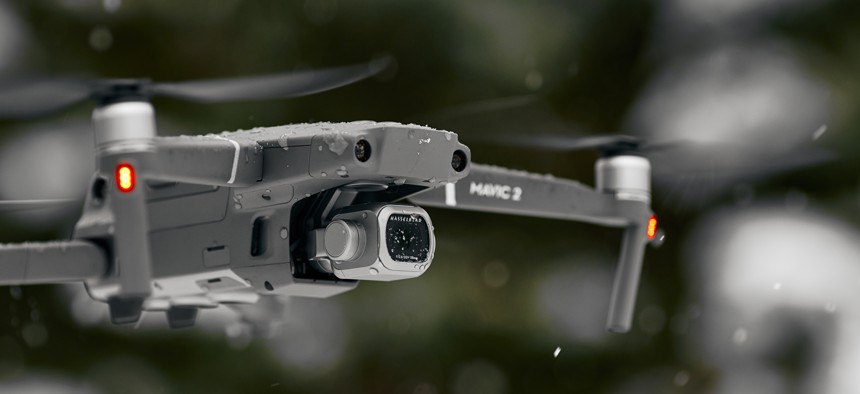
DJI Mavic 2 Pro, flying in wet snow conditions in Rostov-on-Don, Russia. Evgeniyqw/shutterstock
Russia Plans More Arctic UAVs
Moscow’s equivalent of DARPA wants a cold-weather drone that can stay aloft for four days.
An unmanned aircraft that can patrol the top of the world for four days leads a growing list of Arctic-themed drone-engineering projects either planned or underway by Russian defense labs and aircraft manufacturers, state media reports.
A recent report by TASS says the Advanced Research Foundation — essentially, Russia’s six-year-old counterpart to the Pentagon’s DARPA — is working to create materials, electronic components, engines, payloads, and efficient information collection and processing algorithms for use in the Arctic zone. The report also noted work on a drone that can fly for four straight days, as well as demonstrators for technologies that allow vertical and ultrashort takeoff and landing. The Russian government is also funding university-level research into UAVs that can operate in the harsh Arctic climate.
Moscow’s growing interest in cold-weather drones reflects its strategic interest in an Arctic region that climate change is making more accessible but which remains a remote and harsh operating environment. (The challenges were underlined in the deadly January crash of a Tu-22M3 bomber near Murmansk.) Russia is hardly alone in this: as the region becomes more contested, many nations are seeking to beef up their existing militaries for its unique weather conditions. But it does appear to be taking the lead in efforts to develop ways to monitor and observe vast northern reaches via unmanned technologies.
In December, the Kalashnikov Design Bureau announced the ZALA 421-08M and ZALA 421-16E drones for Arctic surveillance. Built to fly for up to 250 minutes in sub-zero temperatures, the drones carry a navigation system specially designed to work without GPS or its Russian equivalent GLONASS.
Related: Russia’s Special Operators Are Getting Futuristic Mini-Subs
Related: Putin Orders Up a National AI Strategy
Related: Here’s How the Russian Military Is Organizing to Develop AI
Soon, this growing family of Arctic-proof UAVs will add another member. The Russian Helicopters Holding is currently conducting tests of the VRT300, a helicopter-style UAV intended to do reconnaissance or haul small cargo loads for either military or civil fleets in new northern sea routes. To provide stability in strong Arctic winds, the VRT300’s coaxial rotors rotate in opposite directions.
Other drones may eventually be modified for Arctic service. A January test flight of the 20-ton Ohotnik long-range combat UAV near Novosibirsk raised eyebrows because it took place in 10-degree Fahrenheit (-12° C) weather. The military-affiliated ZvezdaWeekly speculated that more Arctic testing may be on the way.
Another potential Arctic UAV is the Triada tiltrotor, a vertical-takeoff, horizontal-landing aircraft that can fly from 80 to 160 kilometers in temperatures down to -58 Fahrenheit and observe and film objects out to five kilometers, ZvezdaWeekly wrote.
Meanwhile, the Russian military is already practicing to use drones in Arctic conditions. Last month, the Guards Tank Army of the Western Military District trained with Eleron-3 and Orlan-10 UAVs at low winter temperatures. In December 2018, soldiers in the Central Military District used the Granat-4 UAV while training near Novosibirsk. Other regiments near Tuva, also in southern Siberia, were training with the Orlan-10 around the same time.